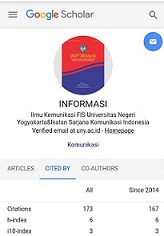MANAGING INTERCULTURAL INTERACTION AND PREJUDICE OF THE INDONESIAN COMMUNITY: AS AN EFFORT TO PREVENT AND MANAGE SARA CONFLICT
Abstract
Interaction and conflict have a very close relationship. Besides, can cause conflicts, interactions can also be used to prevent and manage conflict. There are intrigue and prejudice in dynamic social interaction. Therefore, it takes control of that assessment to others, to be honest, and rational. Individually, prejudice can be controlled through one-way and two-way communication within the family. In groups, prejudice control can be done through the establishment of institutions to communicate more transactional. Social institutions can impose sanctions on anyone proven to produce and disseminate prejudices. Moreover, social institutions can also produce and deploy a symbol of harmony through myth or a true story.
Interkasi dan konflik memiliki hubungan yang sangat erat. Disamping dapat menyebabkan konflik, interaksi juga dapat digunakan untuk mencegah dan menangani konflik. Ada intrik dan prasangka dalam interaksi sosial yang dinamis. Oleh karena itu, dibutuhkan pengendalian agar penilaian terhadap orang lain menjadi jujur dan rasional. Secara individu, prasangka dapat dikendalikan melalui komunikasi satu dan dua arah dalam keluarga. Secara kelompok, pengendalian prasangka dapat dilakukan melalui pembentukan institusi yang dalam berkomunikasi lebih transaksional. Institusi sosial dapat memberi sanksi pada siapapun yang terbukti memproduksi dan menyebarkan prasangka. Selain itu, institusi sosial juga dapat memproduksi dan menyebarkan simbol kerukunan melalui mitos atau kisah nyata.
Keywords
Full Text:
PDFReferences
Blumer, H. (1969). Symbolic Interactionism: Perspective and Method. London: University of California Press, Ltd.
Bodenhausen V. Galen, Todd R. Andrew, and Richeson A. Jennifer. (2009). Handbook of Prejudice, Stereotyping, and Discrimination. Edited by Todd D. Nelson. New York: Psychology Press Taylor & Francis Group.
Bormann, Ernest G. Knutson, Roxann L, Musolf Karen. (1997). “WHY DO PEOPLE SHARE FANTASIES? AN EMPIRICAL INVESTIGATION OF A BASIC TENET OF THE SYMBOLIC CONVERGENCE COMMUNICATION THEORY”. Journal of Communication Studies, 48(03), 254-276.
Bungin, Burhan. (2014). Sosiologi Komunikasi. Jakarta: KENCANA Prenamedia Group.
Dharma, F. A. (2016). “Kritik Terhadap Teori Spiral of Silence: Komunikasi Masyarakat Madura dalam Konflik Sunni-Syi’ah di Sampang”. INFORMASI, 46(1), 1-18.
Floyd, Kory. (2006). Communicating Affection Interpersonal Behavior and Social Context. New York: Cambridge University Press.
Gono, Joyo N. S. 2011. “Resolusi Konflik”. Forum, 30 (2), 86-90.
Hartley, Peter. (1999). Interpersonal CommunicationSecond Edition. New York: Routledge.
Hill, Anne, Watson, James, et., al. (2007). KeyThemes in Interpersonal Communication: Culture, Identities and Performance. Poland: the McGraw Hill companies.
Ilyas. 2014. “Kajian Penyelesaian Konflik Antar Desa Berbasis Kearifan Lokal di Kabupaten Sigi, Sulawesi Tengah”. JURNAL ACADEMICA, 06 (01), 1213-1227.
Kerdchoochuen, Jiraporn. 2011. “Speaking With A Stranger: Intercultural Classrooms’ Tensions And Managing Strategies”. Journal of College Theacing & Learning, 8 (9), 9-17.
Khairil, Muhammad. 2012. “Resolusi Konflik Poso dalam Perspektif Komunikasi Pendidikan Berbasis Agama dan Budaya”. Analisis. X11 (2) 409-430.
Littlejohn, Stephen W., dan Foss K. A. (2011). THEORIES Of HUMAN COMMUNICATION. Tenth Edition. Albuquerque. New Mexico: Wadsworth Publishing Company.
Mead, George, H. (1934). MIND, SELF, and SOCIETY: FROM THE STANDPOINT OF A SOCIAL BEHAVIORIST. Edited and with an introduction by Charles W. Morris. Chicago: THE UNIVERSITY OF CHICAGO PRESS.
Muhammad, Arni. (2005). Komunikasi Organisasi. Jakarta: Bumi Aksara.
Rutherford, J, Stuart, Andrea., et. al. (1990). IDENTITY, Community, Culture, Difference. Edited by Jonathan Rutherford. London: Lawrence & Wishart
Samovar, Larry A., Porter, Richard E., & McDaniel, Edwin R. (2010). Communication Between Cultures. Boston: Wadsworth.
Scott, Ruth, and Scott, W. A. (2005). Adjustment of Adolescents: Cross-cultural Similarities and Differences. New York:Routledge.
Smith, John W. (1977). The Behavior of Communicating An Ethological Approach. USA: Harvard University Press.
Subroto, K. (2016). “KESULTANAN DEMAK: Negara yang Berdasar Syariat Islam di Tanah Jawa”. SYAMINA. Edisi II/Januari 2016.
Suranto. (2010). Komunikasi Sosial Budaya. Yogyakarta: Graha Ilmu.
Ting-Toomey, Stella. (1999). Communicating Across Culture. New York: The Guildford Press.
Wood, T. Julia. (2010). Interpersonal Communication: Everyday Encounters, Sixth Edition. Boston: Wadsworth.
Badan Pusat Statistik. 2016. Mengulik Data Suku di Indonesia (online). https://www.bps.go.id/KegiatanLain/view/id/127. Diakses pada 04 Agustus 2016, pukul 20.00 WIB.
DOI: https://doi.org/10.21831/informasi.v48i2.22961
Refbacks
- There are currently no refbacks.
Copyright (c) 2019 Ferry Adhi Dharma
Supervised by
Our Journal has been Indexed by:
Informasi by http://journal.uny.ac.id/index.php/informasi is licensed under a Creative Commons Attribution-NonCommercial 4.0 International License.














